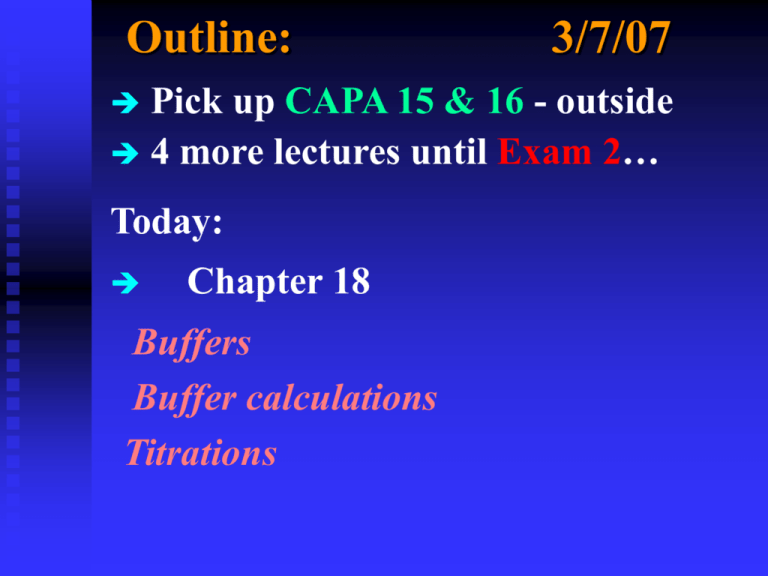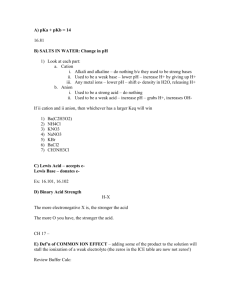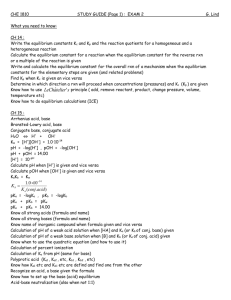Lecture 23
advertisement

Outline: 3/7/07 Pick up CAPA 15 & 16 - outside 4 more lectures until Exam 2… Today: Chapter 18 Buffers Buffer calculations Titrations Lots of problems to practice: Chapter 17: 17.9, 17.11, 17.13, 17.15, 17.17, 17.21, 17.23, 17.25, 17.27, 17.29, 17.31, 17.33, 17.35, 17.37, 17.39, 17.41, 17.43, 17.45, 17.49, 17.51, 17.53, 17.55, 17.57, 17.59, 17.61, 17.63, 17.67, 17.69, 17.71, 17.73, 17.81, 17.83 Lots of problems to practice: Chapter 18: 18.1, 18.3, 18.5, 18.9, 18.11, 18.13, 18.15, 18.17, 18.19, 18.21, 18.23, 18.27, 18.29, 18.31, 18.33, 18.35, 18.37, 18.39, 18.41, 18.45, 18.47, 18.51, 18.55, 18.57, 18.59, 18.61, 18.63, 18.65, 18.67, 18.69, 18.71, 18.73, 18.75, 18.77, 18.79, 18.81, 18.83, 18.85, 18.87, 18.93, 18.101, 18.103 Summary of acid base rxns: weak acid + weak base Keq weak acid + strong base calculations strong acid + weak base solve for x strong acid + strong base pH + pOH = 14 Find Keq from Ka Kb = Kw Acid Base reactions (remember): Add 0.10 mol NaOH to …. (water) No common ions: pH goes from 7.00 to 13.00 change = +6.00 (HOAc/OAc- mix) Common ions: pH goes from 4.74 to 5.11 change = +0.37 Buffer calculations…. pH = pKa + log ([conj base]/[acid]) This one also exists: pOH = pKb + log ([conj acid]/[base]) Practice! Definition: A buffer is usually a mixture of conjugate acid-base pairs in solution. A buffer resists strong changes in pH. pH of a buffer… 0.3 L of 0.4 M acetic acid is added to 0.7 L of 0.2 M sodium acetate, what will be the pH of the resultant buffer? pH = pKa + log ([conj base]/[acid]) pH = 4.75 + log [OAc-]/[HOAc] Do the dilutions: 0.3/1.0 × 0.4 = 0.12 M HA 0.7/1.0 × 0.2 = 0.14 M A- pH of a buffer… 0.3 L of 0.4 M acetic acid is added to 0.7 L of 0.2 M sodium acetate, what will be the pH of the resultant buffer? pH = pKa + log ([conj base]/[acid]) pH = 4.75 + log (0.14/0.12) = 4.75 + 0.07 = 4.82 A buffer example: Human blood must be maintained at a pH of 7.40 0.05 for the rest of the body biochemistry to function. This is achieved with a buffer made from CO2: CO2 (aq) + H2O (l) H2CO3 (aq) If the carbonic acid concentration of a healthy human is 1.3510-2 M, what is the normal human concentration of HCO3-? pH = pKa + log ([conj base]/[acid]) 7.40 = 6.25 + log ([HCO3-]/ 1.3510 -2) [HCO3-] = 1.5210-1 M Rather “twisted” addition to the problem: Inject 10 mL of 1.0 M HCl into a (previously healthy) human with a total blood volume of 8.0 L. What is the new pH? “Buffer capacity” problem How many moles H+ added? 0 .010 L 1.0 mol/L = 0.010 mol How many moles H+ there already? = 10-7.40 = 3.1810-7 mol/L8.0 L = 2.5410-6 mol = negligible! Initial [H+]? [H+]=(0.010 mol+2.5410-6 mol)/ 8.0 L = 1.25 10-3 M [H+] Same old procedure…. H2CO3 HCO3- + H + 1.3510-2 1.5210-1 1.2510-3 I +1.2510-3 -1. 2510-3 -1.2510-3 D 1.4810-2 1.5110-1 0 -x +x +x D solve for x; x = 4.210-8 M; pH = 7.38 Ka = 4. 2710-7: calc in which direction? or use: Easier pH = pKa+log ([conj base] /[acid]) -1/1.4810-2) = 7.38 = 6.37+log(1.5110 to use More Buffer pH… Try another one…. A buffer solution is prepared by mixing 0.300 L of 0.400 M (CH3)3N and 0.700 L of 0.200 M (CH3)3NHCl. What is the pH of this buffer solution? The pKb of (CH3)3N is 4.19. This one also exists: pOH = pKb + log ([conj acid]/[base]) pH= 9.74 Addition of acid/base to a buffer 1.0 L of a buffer solution is prepared with 0.025 M formic acid and 0.010 M sodium formate (pKa = 3.74). If 0.005 mols (0.2 g) of NaOH is added to the solution, what is the pH? OHHCOOH HCOO- + H+ pH = pKa + log ([conj base]/[acid]) pH= 3.74 + log (0.010+0.005/0.025-0.005) or pH = 3.74 – 0.12 = 3.62 Addition of acid/base to a buffer What if you exceed the buffer capacity? If 0.050 mols (2.0 g) of NaOH is added to the solution, what is the pH? pH = pKa + log ([conj base]/[acid]) pH= 3.74 + log (0.010+0.050/0.025-0.050) Simply neutralize Not defined! 0.025 mols, and = 0.025 M OH calculate the pOH of the remainder… Or pH = 12.4 weak acid Buffer region Equivalence point Mid-point of OH- added







